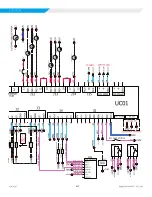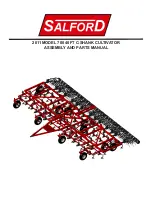
INSTALLATION
MAGNITUDE WMT CHILLER
DAIKIN APPLIED
6
Clearance
The unit must be placed in an area that allows for adequate
clearance around the unit. See
Figure 6
for clearance
requirements around the sides of the chiller. Doors and
removable wall sections can be utilized to meet these clearance
requirements. There must be a minimum 3-foot clearance above
the top of the chiller. The U.S. National Electrical Code
®
(NEC) or
local codes can require more clearance in and around electrical
components and must be checked for compliance.
Mounting
The unit must be mounted on a concrete or steel base. Make
sure that the floor or structural support is adequate to support the
full operating weight of the complete unit.
WMT chillers are nearly vibration-free. Consequently, floor
mounted spring isolators are not usually required. Neoprene
mounting pads are shipped with each unit. It is recommended
to continue to use flexible piping connectors to reduce sound
transmitted into the pipe and to allow for expansion and
contraction.
It is not necessary to bolt the unit to the mounting slab or
framework. Should this be required by local codes, 1-1/8 inch
(1.125 inch, 28.5 mm) mounting holes are provided in the unit
supports at the four corners. When mounted, the base pad of the
unit must be level to within ± 1/2 inch (0.5 inch,12.7 mm) across
the length and width of the unit.
1 .
Units with single point power, 575V, and/or the optional
harmonic filter will require additional panels than shown in
Figure 7
.
Lifting Guidance
Daikin Applied equipment is designed to withstand the loads of
the lifting and rigging process resulting from ASME Standard
P30.1 - Planning for Load Handling Activities or equivalent.
Lifting guidance is intended for installations of newly delivered
equipment. If moving previously installed equipment for re-
location or disposal, consideration should be given to unit
condition. Equipment should also be drained as unit weight and
center of gravity values do not reflect the addition of water for
lifting.
DANGER
Improper rigging, lifting, or moving of a unit can result in unit
damage, property damage, severe personal injury or death. See
the as-designed, certified dimensioned drawings included in the
job submittal for the weights and center of gravity of the unit. If
the drawings are not available, consult the local Daikin Applied
sales office for assistance.
Installation is to be performed only by qualified personnel who
are familiar with local codes and regulations, and experienced
with this type of equipment. Lifting equipment and mechanisms
must be determined by the Lifting Director per the current version
of ASME Standard P30.1 or equivalent and must be suited for the
load capacity.
Daikin Applied is not a licensed nor certified rigging specialist.
Therefore it is the customer’s responsibility to consult a certified
rigging contractor to rig, lift, and move components and
subcomponents properly and safely as needed.
CAUTION
Forklifts may not be used to lift or move WMT units as the
method may result in unit damage.
CAUTION
When around sharp edges, wear appropriate Personal Protective
Equipment (PPE), such as gloves, protective clothing, foot wear,
eye protection, etc. to prevent personal injury.
Lifting Brackets
Lifting bracket designs vary from product to product. Rules of
engagement with the lifting brackets are the same regardless of
the bracket type.
For
WMT
units, a typical lifting bracket with 2ʺ (51 mm) diameter
holes found on the upper corners of each end cap are illustrated
in
. See the as-designed certified drawings for specific
lifting points on this product model.
Engagement with each bracket is to be as close to vertical as
possible. The maximum allowable lift angle from the vertical is 30
. If the lift angle shifts beyond 30°
from vertical on any of the lift points, the lift shall not proceed until
a plan and rigging can be secured that will correct the angle of
lift.
WARNING
The lifting angle must not go beyond 30 degrees from vertical or
the unit can become unstable which may result in unit damage,
property damage, severe personal injury, or death.
Figure 2: Illustration of Lifting Bracket and Allowed Angle for
Lifting







































